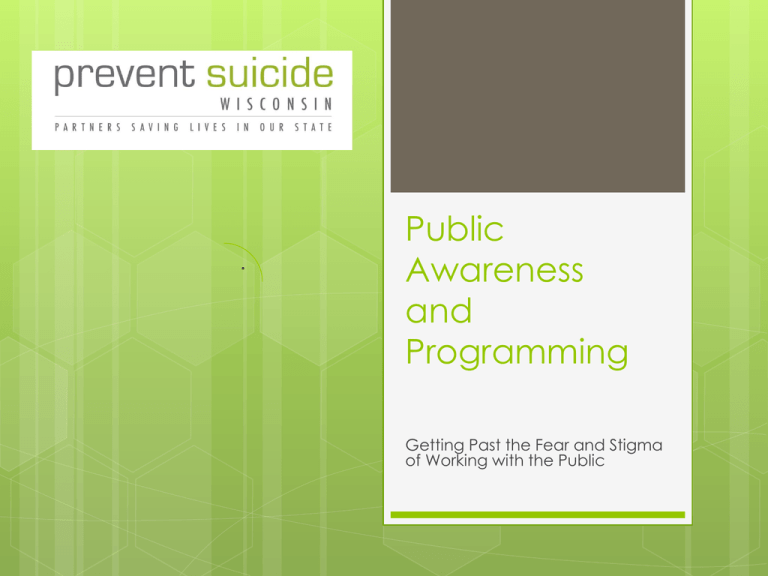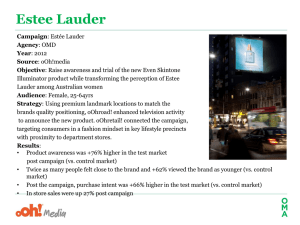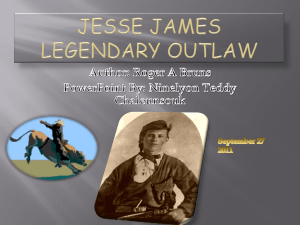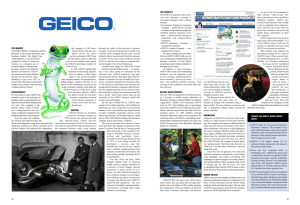
.
Public
Awareness
and
Programming
Getting Past the Fear and Stigma
of Working with the Public
Public Awareness
If you participated in the previous two webinars,
you will see that building public awareness goes
hand in hand with fundraising and coalition
building. You can’t do any one of these without
including the other two.
A Short Review
The Coalition
Start with your mission and vision statements
These determine who you are and what your
coalition is about – something you want to convey
to the public
Help determine your branding
Help determine your goals and objectives
A Short Review
Your Strategic Plan –
From the mission and vision statements, you
determine your goals and objectives for the short
and long term
Your plan helps you determine your audience for
your message and how you want to portray it – your
campaign
A Short Review
SAMPLE STRATEGIC PLAN
Mission Statement:
Vision Statement:
Long Term Goal
Medium Term Goal
Short Term Goal
Focus
Audience
Objective 1
Lead
Responsibility
Completion
Date
Evaluation Indicators
1.
Tasks
Objective 2
Tasks
1.
A Short Review
While your public awareness program may or may
not need funding, you need to keep in mind that
your message may be a way to gain additional
support for your coalition and its other needs.
Keep your audience and the general public in mind.
Public Awareness
Depending on your plan, your public awareness
program may be about your branding or your
campaign.
Brand vs. Campaign
These are very different things and need to be kept in
perspective. Your brand is your identity – your logo,
your mission statement. It usually does not change
drastically.
Your campaign is a current message that you want to
convey. It can change often and more than one
campaign can run at one time – if you can handle it.
Public Awareness
Example:
United Way
We all realize this logo as the symbol for
The United Way. While it might change slightly over
the years, it basically stays the same and is readily
recognized by all. This is the United Way’s BRAND.
Public Awareness
Example:
United Way
However, every two to three years, the United Way
will change its fundraising plan by developing a new
campaign – such as the current one – LIVE UNITED.
Public Awareness
Example:
GEICO
Geico has a logo that has seen little change over
the years.
Public Awareness
Example:
GEICO
Yet Geico runs many
campaigns at once.
Public Awareness
So let’s get back to our reality and talk about our
own Awareness programs:
Most, if not all coalitions have adopted a logo –
whether it’s the branded one related to that above,
or your own. It is your identity.
No matter what you decide as your campaign,
make sure your name is somehow attached. If you
spend the time and in some cases, the money,
make sure you get the recognition.
Public Awareness
We don’t have the time in this forum to develop various
public awareness programs – but there are things that
all successful campaigns have in common:
A definition of the problem – “Suicide takes X lives in
our community each year”
Setting your organization as the “expert” in suicide
prevention and awareness – the go-to people when
questions or concerns arise
A push for action – “Suicides can be reduced by
being aware of the signs of suicide, alleviating the
stigma that surrounds mental illness and suicide, and
where to go for help”
A system of being able to respond well to inquiries
and the needs of the public
Public Awareness
A
definition of the problem – “Suicide takes X lives
in our community each year”
Choose your message well and be consistent. Be
sure it remains the same throughout the campaign.
Changing a phrase, or the way the message is
delivered can also change the perception of that
message, thus confusing people. If people are
confused, the message is forgotten.
Public Awareness
Setting
your organization as the “expert” in suicide
prevention and awareness – the go-to people when
questions or concerns arise
Tell them that you know what you are doing – and
be ready to back it up with facts and figures. Be sure
that there are designated members of the coalition
that will respond to media and/or public inquiries –
to help keep that consistent message, thus
establishing the expertise.
Public Awareness
A
push for action – “Suicides can be reduced by
being aware of the signs of suicide, alleviating the
stigma that surrounds mental illness and suicide, and
where to go for help”
Do you want them to visit your website for more
information? Join the coalition? What is the most
efficient way to get your message across to your
chosen audience? The media? Which forms?
Television, radio, or newspaper? All three? What can
you afford to do? What can you get for “free?”
Public Awareness
For example, perhaps you decide to put together an
awareness campaign for elderly men. What media
would you choose – why?
Now, consider a teen campaign – what media
would you choose? Why?
The best thing to do? Ask a few people who
represent the audience you are hoping to reach.
After all, they are the experts!
Public Awareness
A
system of being able to respond well to inquiries
and the needs of the public
No matter what your message and to whom, have
the procedures in place to handle inquiries and
concerns.
Be sure to have the appropriate organizations on
board with your campaign – those who may have to
deal with the increased calls, admissions, and so on
– the crisis centers, law enforcement, emergency
rooms, walk-in clinics, etc. Make sure they are kept
aware of your plan and have input as to how
inquiries should be handled.
Public Awareness
You don’t have to recreate the wheel!
Many campaigns are already out there for your study
and use. There are counties who have already put
together awareness projects just as remembrance
walks, dinners, social events and more. Talk to them.
Prevent Suicide Wisconsin has the public service
announcements available, featuring Suzy FavorHamilton for awareness campaigns, and other
helpful information on the website. We also have
the wallet cards and means restriction brochures
available for use.
Public Awareness
You don’t have to recreate the wheel!
SPRC, AAS, NAMI, NIMH, and others have programs
available for your use – most are free. Check them
out online, too!
Public Awareness
Campaign Examples: HOPES
Public Awareness
Campaign Examples: SAVES
Campaigns can be viewed and purchased:
http://www.save.org/index.cfm?fuseaction=home.viewPage
&page_id=3836F2F3-7E90-9BD4-C93AEF2B191DF58D
Public Awareness
The Media is Your Friend!
Some ways of getting the buy-in of the media:
Remember,
you have a need and so do they. You
need to reach the public, they need to get ratings.
Provide
information that is timely and attention
grabbing – it piques the interest of the public,
therefore the media
Public Awareness
Help
them as much as you can – provide stats,
stories, a human interest angle, etc. that helps the
reporter put a full story together – a reason for
reporting it
Keep
them up to date with new developments
and be honest with them – keep your integrity
Public Awareness
Be sure to thank the media outlets you choose
and carry the story – let them know you
appreciate their partnership in the wellbeing of
the community
Public Awareness
To read examples of appropriate and problematic
reporting on suicide, visit the following Web site
to access “Reporting on Suicide: A Resource for
the Media,”
www. afsp.org/education/recommendations/index.html.
You can assist the local media in their reporting
about suicide by also referring them to an SPRC
document online:
www. sprc.org/library/at_a_glance.pdf.
Public Awareness
Which media should you use?
Totally depends on your audience and message!
Again, ask those who represent that audience –
where do they get their information? Television?
Radio? Newspapers? Online news? Facebook or
other social media? How do they access it? How
often?
You save yourself time, money, headaches and
embarrassment.
Public Awareness
Engaging the media may start with an overlying
press release. To gain the attention of the reporter:
Grab the reporter’s attention with strong lead sentence or short
paragraph, which conveys your key message.
Write in short, concise sentences and paragraphs – provide
important information, data, and statistics. Avoid extraneous
details.
Emphasize the local angle.
Public Awareness
Engaging the media may start with an overlying
press release. To gain the attention of the reporter:
Include a quote from your organization’s spokesperson or
expert. This lends more credibility.
Be sure to answer the basic questions: who, what, when, where,
why, and how. Don’t forget to include the date!
Keep it to one page.
Include contact information and your Web site.
Public
Awareness
Sample
Press Release
Public Awareness
As with any project on your strategic plan, measure
how well your public awareness campaign has
worked. (This is why it’s good to have a call to
action in your message.)
There is no exact science on measuring the
outcomes of working with the media other than
subjective measurements like increased calls to
the crisis line, increased visits to the ER or crisis
center, increased visits to the website, etc. But
they can help. Perhaps partner with these folks to
ask callers/patients where they heard about the
services?
Don’t Forget!!!
Debi Traeder
Suicide Prevention Coordinator
Mental Health America-Wisconsin
715/551-0966
traeders@charter.net
Shel Gross
Mental Health America-Wisconsin
608/250-4368
shelgross@tds.net
Special thanks to:
Denise Pazur and PDV Foundation for their
assistance with today’s webinar
The Kubly Foundation for its support
SPRC for information regarding working with the media









